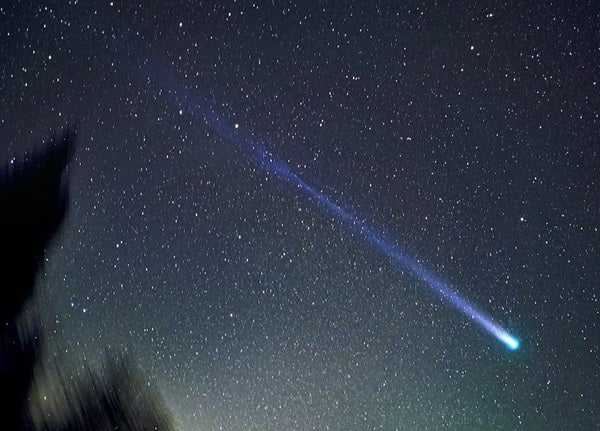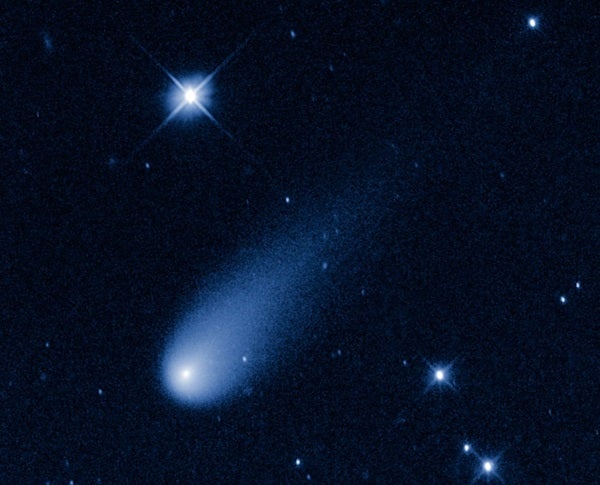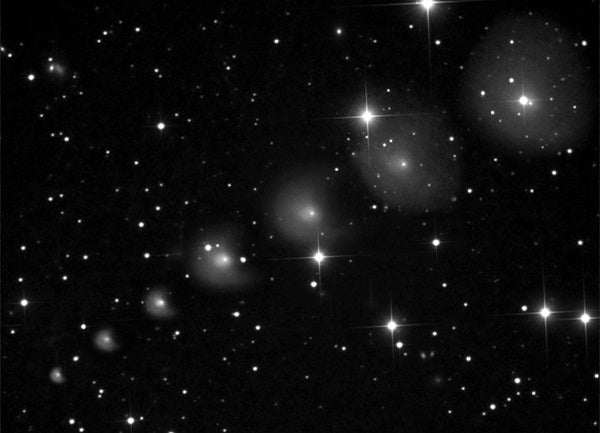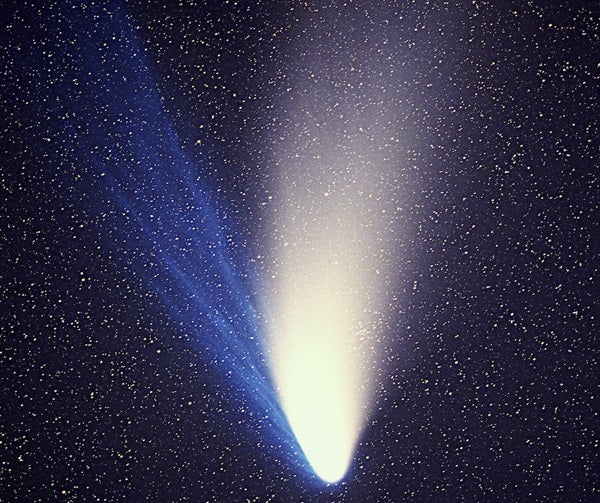Lucky are those who have seen a great naked-eye comet, one with a head and tail so intense that you need only look up to see it. It’s a rarity: On average, such a comet — brighter than magnitude 0 — appears once every 15 years. Fortunately, several fainter comets that are visible through binoculars or small- to medium-sized telescopes grace the skies each year.
To many, hunting down and monitoring these fuzzy, frozen fragments left over from the formation of our solar system is one of the most satisfying pastimes of our hobby, linking us to celestial sights that have influenced humanity throughout the ages. And for those wishing to get into the exciting pursuit of observing comets, here’s what you need to know.
Start a comet watch
Most serious comet-watchers monitor the brightness and extent of a comet’s two main features: its head and its tail. By studying them, astronomers can gain a better understanding of how comets shed their dust and release their gas.
The head is made of a diffuse shell of dust and gas (the coma; Latin for “hair of the head”) and a starlike core (the pseudo-nucleus). A comet’s tail can include a dust tail, an ion tail, or both.
While brighter comets can be superb sights to the unaided eyes or binoculars, most telescopic comets appear as breathy glows whose shapes and sizes mimic faint star clusters or dim face-on galaxies. Yet comets also possess an almost mystical allure, shining with a neighborly light that distant deep-sky objects cannot replicate. Like planets, comets primarily shine by reflecting sunlight. They also wander across the starry background sky, changing position slightly night after night.
But comets can also change their appearance on a whim — that’s what makes them so exciting to observe! A comet may suddenly surge in brightness overnight or fizzle out in just a few short days. One important aspect of observing comets, then, is to estimate the brightness of the comet’s coma.
Checking recent reports for the brightness of comets can help you to decide which objects to pursue, as only you know the limits of your equipment. While recent observations are useful as selection guides, do not rely on them when you go out to observe. Comets are as predictable as uninvited house guests. One key resource for accurate information regarding news, observations, orbital data, designations, and names — as well as good links for comets and related topics — is The International Comet Quarterly (ICQ) Comet Information Website (www.icq.eps.harvard.edu).
Estimating magnitude
Determining a comet’s brightness starts with an assessment of its apparent size and its degree of condensation (DC), a measure of how tightly concentrated the light from the coma appears. The coma may be anywhere from a few arcminutes to several degrees in apparent size, while the DC value varies from 0 to 9.
DC = 0 represents a comet with a uniformly diffuse coma, with no discernible brightening from the outer edge of the coma to the center. DC = 5 means the comet is moderately condensed, showing a distinct brightening toward the center. DC = 9 represents a nearly stellar appearance, where almost all the brightness is concentrated at a central point or within a tiny disk; this is hardly ever seen.
While all DC values are somewhat subjective because they depend heavily on the brightness of the background sky, they, in combination with a comet’s size, will help you determine which specific method to use when estimating the brightness of a comet’s coma. The ICQ recommends the following three methods:
In-Out (Vsekhsvyatskij-Steavenson-Sidgwick [VSS]) method: This approach is best for diffuse comets that do not display a strong central condensation (i.e., those with low DC values). The observer compares an in-focus image of the comet to nearby comparison stars that have been defocused to appear the same size as the comet’s coma.
Out-Out (Van Biesbroeck-Bobrovnikoff-Meisel [VBM]) method: This is the easiest method to use and is appropriate for naked-eye comets with small comas (i.e., high DC values). The observer slightly defocuses the comet and its comparison stars by the same amount until they appear the same size.
Modified-Out (Morris-O’Meara) method: Best for moderately condensed comets, the observer uses this method to defocus the comet’s inner core first, until the brightness gradient between the inner and outer coma appears smooth. That image is then compared multiple times in the same night to stars that are defocused to match the comet’s out-of-focus image.
Note that in all three methods, it’s best to use comparison stars near the comet, or those in the same part of the sky and preferably at the same altitude as the comet.
Comet tails and how to measure them
Comets have two principal types of tails: a dust tail (type II) and an ion tail (type I). When visible, dust tails are the easiest to observe, as dust efficiently reflects sunlight, which is primarily how comets shine. The dust tail originates from the comet’s head and points away from the Sun, appearing brightest near the coma before gradually fading downwind. Dust tails can also dramatically curve, especially around the time of perihelion passage — or closest approach to the Sun — when dust freed from the nucleus follows the curved path of the comet’s orbit.
Another remarkable feature of dust tails are striations called synchrones. Though not well understood, they appear to be due to streams of debris that periodically erupt from the comet’s nucleus as it rotates. Forces such as gravity, solar wind, and radiation pressure then act upon these streams, causing the delicate patterns we see. The tail of Comet C/2006 P1 (McNaught) was so resplendent with striations that the farthest tips were visible from parts of the Northern Hemisphere, despite the fact the comet’s head and most of its tail were only visible from the Southern Hemisphere.
Some comets are bright enough for the cone cells in our eyes to detect their color, which can reveal whether the comet is richer in gas or dust. Yellow implies dust, while blue implies gas. Some comets also display green heads, a result of ultraviolet radiation breaking down diatomic carbon molecules (C2 ), causing the head, and only the head, to fluoresce. The tails of dusty comets usually shine with a white or pale-yellow light, like straw under a setting Sun. When bright dust tails are seen close to the horizon, they can also take on a reddish hue due to dust or other contaminants in Earth’s atmosphere, making them appear like bloody swords.
Ion tails, meanwhile, require greater effort to observe. They consist of electrically charged, glowing molecules, or ions, that follow the path of the solar wind almost exactly. The most common ion, CO+ (carbon monoxide), absorbs sunlight and fluoresces at a wavelength of 420 nanometers, so ion tails tend to appear blue. Some observers, especially those with eyesight particularly sensitive to blue light, can see them clearly. English astronomer George Alcock was renowned for his observations of comet ion tails. Most observers, however, must work a bit to see them, especially when faint.
If an ion tail is present, use averted vision and sweep your telescope back and forth across the area of the sky behind the comet’s head in the anti-solar direction. The same method can be used for naked-eye comets with a long ion tail — only in this case, sweep your eyes back and forth across the sky. The latter is the same technique an observer would use to bring out the zodiacal light against the background sky.
If a gaseous comet passes close to Earth, it can be an awe-inspiring sight. Such was the case with C/1996 B2 (Hyakutake), which came within 9.3 million miles (15 million kilometers) of Earth, or about 40 times the Earth-Moon distance. At its closest, Hyakutake’s head swelled to greater than four Full Moon diameters, while its tail stretched more than halfway across the sky like a banner of pale light.
Ion tails often display hairlike streamers or braided (ropey) flows of gas. These tails can also appear frayed, with structures branching off from the main tail. Among the most remarkable phenomena associated with ion tails, however, is a disconnection event. These are triggered either by debris violently ejected from the comet’s surface or by coronal mass ejections from the Sun slamming into the comet. Disconnection events occur when strong fluctuations in the solar wind pinch the magnetic field lines in the ion tail together, forming a knot that releases a powerful burst of energy strong enough to sever the tail, causing it to drift away. In some bright comets, knots and the resulting disconnection events can be observed with unaided eyes.
Finally, very rarely, comets can display anti-tails (type III) that appear when Earth passes through or close to the plane of a comet’s orbit around the Sun. When this occurs, we see dust in the comet’s orbit edge-on, causing it to appear like a sunward-pointing tail that lags behind the comet. Because anti-tails reflect sunlight, they are not difficult to see. Look for a long, slender lance (sometimes surrounded by an ellipsoidal envelope) or a triangular wedge fanning out from the comet’s head. What we see depends on our viewing angle: The more needlelike the anti-tail, the closer Earth is to the comet’s orbital plane.
Whatever tails are visible during your next observing session, you can determine their lengths and position angles by recording the positions of the comet’s head and tail against the background stars, then plotting them on a star chart. Next, measure the length of the tail (usually in arcminutes or degrees) from where it comes off the comet’s head to its tip. To determine position angle, use a protractor to measure the tail’s orientation relative to the center of the coma, with north at 0°/360°, east at 90°, south at 180°, and west at 270°. For comets with broad dust tails, measure the two endpoints of the tail’s width and record the extent; for example, a dust tail may sweep across the sky from a position angle of 45° to 90°.
Finer details
Let’s now shift our attention to some of the more dynamic features comets can display. To observe them, you’ll want to start by surveying the comet’s head with your telescope at its highest effective magnification. While 50x per inch of aperture is comfortable, don’t be afraid to push the power to 75x to 100x per inch of aperture, especially if you are using a high-quality scope under excellent atmospheric conditions.
When visible, the pseudo-nucleus lies at the heart of a comet’s coma. As the name implies, the pseudo-nucleus is not the comet’s true nucleus, which, at generally only a few miles wide, is much too small and faint to resolve. The region around the pseudo-nucleus is where much of the most dynamic activity occurs. Watch for sudden surges in brightness, as they may signal the breakup of the nucleus, creating secondary nuclei. Such surges may also be caused by violent releases of dust-laden ice, especially as the comet nears the Sun. Some comet nuclei flare several times in a matter of days, which can add a new level of excitement to your session.
More common transient features are jets — high-velocity geyserlike eruptions emanating from the nucleus, which pierce the coma from various directions on its Sun-facing side. Jets are most intense near the pseudo-nucleus and gradually fade away at greater distances. Except for the brightest of comets, these features are generally of low contrast and require both patience and time to see. Typically, jets appear only slightly brighter than the surrounding coma, so the best approach is to use high power to diffuse the coma, which makes the jets stand out more prominently.
As the nucleus rotates and jets spiral outward, they can form a series of parabolic hoods (which look like bow waves that form at the front of a ship). Some of the most active comets also produce bold, sunward-facing jets that look more like broad plumes than rays or fans. These plumes fountain away from the pseudo-nucleus in sweeping gestures before curving back into the tail.
Don’t forget: Comets are unpredictable! Who knows what other surprising features await? The only way to find out is to keep observing any comets you can. One of the greatest pleasures in comet observing is the thrill of witnessing the unexpected. As American physicist Leonard Susskind reminds us, “Unforeseen surprises are the rule in science, not the exception.”
May the next bright comet dazzle us all.















